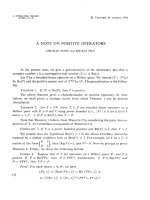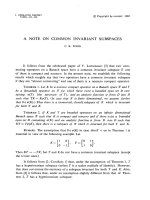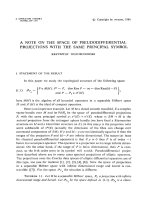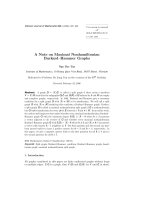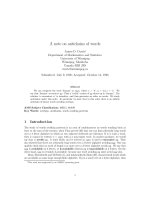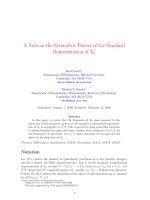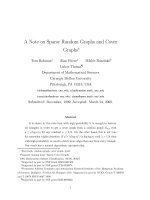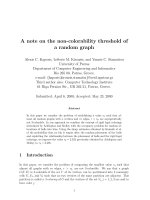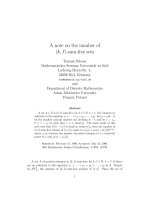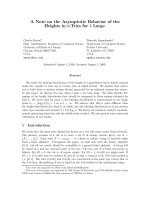Báo cáo toán học: "A note on an identity of Andrews" docx
Bạn đang xem bản rút gọn của tài liệu. Xem và tải ngay bản đầy đủ của tài liệu tại đây (56.91 KB, 3 trang )
A note on an identity of Andrews
Zhizheng Zhang
∗
Department of Mathematics, Luoyang Teachers’ College,
Luoyang 471022, P. R. China
Submitted: Jan 26, 2005; Accepted: Feb 23, 2005; Published: Mar 7, 2005
Mathematics Subject Classifications: 33D15, 05A30
Abstract
In this note we use the q-exponential operator technique on an identity of Andrews.
1 Intro duction
The following formula is equivalent to an identity of Andrews (see [3] or [1]):
d
∞
n=0
(q/bc, acdf; q)
n
(ad, df; q)
n+1
(bd)
n
− c
∞
n=0
(q/bd, acdf; q)
n
(ac, cf; q)
n+1
(bc)
n
= d
(q,qd/c,c/d,abcd,acdf,bcdf; q)
∞
(ac,ad,cf,df,bc,bd; q)
∞
. (1)
Liu [3] showed it can be derived from the Ramanjan
1
ψ
1
summation formula by the q-
exponential operator techniques. In this short note, again using the q-exponential operator
technique on it, we obtain a generalization of this identity. We have
Theorem 1.1. Let 0 <| q |< 1. Then
d
∞
n=0
(q/bc, q/ce, acdf; q)
n
(ad, df; q)
n+1
(q
2
/bcde; q)
n
q
n
− c
∞
n=0
(q/bd, q/de, acdf; q)
n
(ac, cf; q)
n+1
(q
2
/bcde; q)
n
q
n
= d
(q,qd/c,c/d,abcd,acdf,bcdf,acde,cdef,bcde/q; q)
∞
(ac,ad,cf,df,bc,bd,ce,de,abc
2
d
2
ef/q; q)
∞
. (2)
∗
This research is supported by the National Natural Science Foundation of China (Grant No.
10471016).
the electronic journal of combinatorics 12 (2005), #N3 1
2 The proof of the Theorem
The q-difference operator and the q-shift operator η are defined by
D
q
{f(a)} =
1
a
(f(a) − f(aq))
and
η{f (a)} = f (aq),
respectively. In [2] Chen and Liu construct the operator
θ = η
−1
D
q
.
Based on these, they introduce a q-exponential operator:
E(bθ)=
∞
n=0
(bθ)
n
q
(
n
2
)
(q; q)
n
.
For E(bθ), there hold the following operator identities.
E(bθ) {(at; q)
∞
} =(at, bt; q)
∞
, (3)
E(bθ) {(as, at; q)
∞
} =
(as, at, bs, bt; q)
∞
(abst/q; q)
∞
. (4)
Applying
(q/a; q)
n
=(−a)
−n
q
(
n+1
2
)
(q
−n
a; q)
∞
(a; q)
∞
, (5)
we rewrite (1) as
d
∞
n=0
(acdf; q)
n
(ad, df; q)
n+1
−
d
c
n
q
(
n+1
2
)
·
(q
−n
bc, bd; q)
∞
−c
∞
n=0
(acdf; q)
n
(ac, cf; q)
n+1
−
c
d
n
q
(
n+1
2
)
·
(q
−n
bd, bc; q)
∞
= d
(q, qd/c,c/d,acdf; q)
∞
(ac,ad,cf,df; q)
∞
·{(abcd, bcdf; q)
∞
} . (6)
Applying E(eθ) to both sides of the equation with respect to the variable b gives
d
∞
n=0
(acdf; q)
n
(ad, df; q)
n+1
−
d
c
n
q
(
n+1
2
)
· E(eθ)
(q
−n
bc, bd; q)
∞
−c
∞
n=0
(acdf; q)
n
(ac, cf; q)
n+1
−
c
d
n
q
(
n+1
2
)
· E(eθ)
(q
−n
bd, bc; q)
∞
= d
(q, qd/c,c/d,acdf; q)
∞
(ac,ad,cf,df; q)
∞
· E(eθ) {(abcd, bcdf; q)
∞
} . (7)
the electronic journal of combinatorics 12 (2005), #N3 2
Again, applying the results (3) and (4) of Chen and Liu, we have
E(eθ)
(q
−n
bc, bd; q)
∞
=
(q
−n
bc, bd, q
−n
ce, de; q)
∞
(q
−n
bcde/q; q)
∞
, (8)
E(eθ)
(q
−n
bd, bc; q)
∞
=
(q
−n
bd, bc, q
−n
de, ce; q)
∞
(q
−n
bcde/q; q)
∞
(9)
and
E(eθ) {(abcd, bcdf; q)
∞
} =
(abcd, bcdf, acde, cdef; q)
∞
(abc
2
d
2
ef/q; q)
∞
. (10)
Substituting these three identities into (7) and then using
(q
−n
a; q)
∞
=(−a)
n
q
−
(
n+1
2
)
(q/a; q)
n
(a; q)
∞
, (11)
we have
d
(bd, de, bc, ce; q)
∞
(bcde/q; q)
∞
∞
n=0
(q/bc, q/ce, acdf; q)
n
(ad, df; q)
n+1
(q
2
/bcde; q)
n
q
n
−c
(bc, ce, bd, de; q)
∞
(bcde/q; q)
∞
∞
n=0
(q/bd, q/de, acdf; q)
n
(ac, cf; q)
n+1
(q
2
/bcde; q)
n
q
n
= d
(q,qd/c,c/d,acdf,abcd,bcdf,acde,cdef; q)
∞
(ac,ad,cf,df,abc
2
d
2
ef/q; q)
∞
. (12)
Henceweget
d
∞
n=0
(q/bc, q/ce, acdf; q)
n
(ad, df; q)
n+1
(q
2
/bcde; q)
n
q
n
− c
∞
n=0
(q/bd, q/de, acdf; q)
n
(ac, cf; q)
n+1
(q
2
/bcde; q)
n
q
n
= d
(q,qd/c,c/d,abcd,acdf,bcdf,acde,cdef,bcde/q; q)
∞
(ac,ad,cf,df,bc,bd,ce,de,abc
2
d
2
ef/q; q)
∞
. (13)
The proof is completed.
References
[1] G.E.Andrews,Ramanujan’s ”lost” notebook. I. Partial θ-functions, Adv. in Math. 41
(1981), 137-172 .
[2] W.Y.C.Chen-Z.G.Liu,Parameter augmentation for basic hypergeometric series,
I, in: B. E. Sagan, R. P. Stanley (Eds.), Mathematical Essays in honor of Gian-Carlo
Rota, Birkauser, Basel. 1998, pp. 111-129
[3] Z. G. Liu, Some operator identities and q-series transformation formulas, Discrete
Math. 265(2003), 119-139.
the electronic journal of combinatorics 12 (2005), #N3 3
